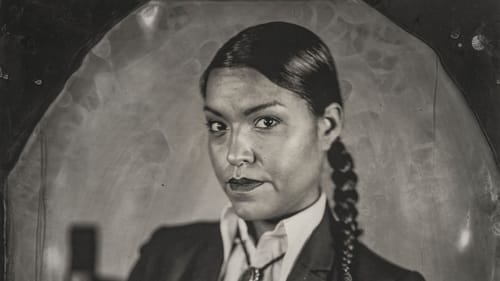Stay in the Loop
BSR publishes on a weekly schedule, with an email newsletter every Wednesday and Thursday morning. There’s no paywall, and subscribing is always free.
A new Indigenous archive
The Delaware Art Museum presents In Conversation: Will Wilson

In the technically brilliant and deeply moving Will Wilson exhibition at the Delaware Art Museum, aptly titled In Conversation, multiple dialogues ricochet around the gallery: the artist with the viewer, Wilson with his history, the artist with his chosen process, and (clearly of great import) Wilson’s communication with his subjects as they both explore what it means to make a portrait.
Diné (Navajo) photographer Will Wilson (b. 1969) created these black-and-white portraits as part of his decade-long Critical Indigenous Photographic Exchange (CIPX), now housing 4,000 photographs. He instituted the project in 2012 to create a contemporary vision of Native North America facilitating “new conversations about Indigeneity that emphasize a reciprocal relationship with the sitters.” CIPX reframes the work of Edward Curtis, who from 1907-1930 created The North American Indian, an influential photographic archive whose editorial view has kept the Native people it depicts visually frozen in time. Wilson asked himself what it would look like “if Indians invented photography,” and then the artist set about creating his own archive.
Subjects as collaborators
Wilson sees portraiture as ceremony, engaging a sitter as a collaborator. The subject chooses how to be portrayed, dressing as they see themselves. Wilson is based in Santa Fe, New Mexico, so, not surprisingly, 17 of the images are from the western tribes whose names resound in our history—Navajo, Sioux, Cherokee, Hopi, Chickasaw, Apache. In May, Wilson traveled to Delaware to photograph members of the Lenape Indian Tribe of Delaware and the Nanticoke Indian Tribe. Thirteen of those images are also on view here.
Both Wilson’s process and content are strongly historic and yet strikingly contemporary, bridging three centuries. He makes tintypes (images on metal plates) using 19th-century wet plate collodion, an amalgam of alchemy and chemistry. He then scans digital copies for CIPX and gives the actual tintype (“the silver object that holds their image”) to his sitter. These photographs are thus redolent with the drops, smears, and blurs characteristic of this process (and each specific lens), mesmerizing portraits imbued with both photographic history and the complicated, heart-rending Native experience. Further linking past and present, some images have an Augmented Reality (AR) app that brings them to life as “Talking Tintypes.”
Especially powerful are Michelle Cook, Citizen of the Navajo Nation (2013) and Nakotah LaRance, Citizen of the Hopi Nation
(2012), six-time world champion Hoop Dancer. There are also stellar 2022 portraits of two regional leaders: Nanticoke Chief Natosha Carmine and Lenape Chief Dennis J. Coker. But one image most clearly shows the genesis of CIPX.

In Andy Everson, Artist, Citizen of the K’omoks First Nation (2017), Everson holds an Edward Curtis image of his grandmother. Curtis “costumed” his sitters (here for a 1914 film he produced), and so his portraits reflected the photographer’s view, not the sitters’ image of themselves. This eye-opening exhibition creates a tectonic consciousness shift, excavating the very fine line between artistic exploration and image appropriation that Wilson mines and transmutes.
Out of history and into the present
With one exception, these layered, beautiful portraits look directly at the viewer. That exception is the exhibition’s signature image, How the West Is One (2014/2016), a beautiful double self-portrait. Here, the artist faces inward to the center, gazing at himself attired in both native dress and western “cowboy” garb. Wilson’s split view of his identity contains the kernel of his message and illuminates the dichotomy that fuels and inspires this remarkable, layered work.
There is also a small section of recent work (five Talking Tintype images and a video) that expands CIPX parameters by exploring the 1921 lynching of Mr. Fred Rouse that features Adam W. McKinney, an African American dance professor at Texas Christian University. And throughout, informative wall text and labels are bilingual (English and Spanish).
Wilson’s work has been highly recognized, and this important exhibition was organized by Crystal Bridges Museum of American Art. In Delaware, In Conversation was curated by Heather Campbell Coyle, who surrounds images with ample space, allowing them room to speak. Community engagement specialist Iz Balleto and DelArt educators created a series of meaningful programs, including a packed and powerful regional Powwow in July, and the exhibition’s guest curator was Kaila T. Schedeen.
Wilson’s oeuvre is infused with overwhelming passion and deep humanism: “You find a simple project and it propels you.” These remarkable images propel themselves and us as well, moving out of history and off the wall to land powerfully in the present.
What, When, Where
In Conversation: Will Wilson. Through September 11, 2022, at Delaware Art Museum, 2301 Kentmere Parkway, Wilmington, DE. $6-$14; free for children under 6 and free on Thursdays, 4-8pm, and Sundays, 10-4pm. (302) 571-9590 or delart.org.
Masks are optional inside the museum and required in the auditorium, on tours, and in studio classes.
Accessibility
Delaware Art Museum and the Copeland Sculpture Garden are wheelchair accessible, with free parking and a barrier-free entrance. Wheelchairs are available; personal care attendants are admitted free.
Sign up for our newsletter
All of the week's new articles, all in one place. Sign up for the free weekly BSR newsletters, and don't miss a conversation.
 Gail Obenreder
Gail Obenreder